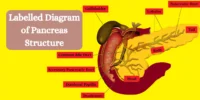The female reproductive system is one of the most important systems in the human body, ensuring the continuation of life. It is essential for creating female gametes (eggs), promoting fertilisation, and encouraging fetal development during pregnancy. Biology and medicine students, as well as anyone interested in studying how the human body works, must understand its anatomy and functions.
Major Functions of the Female Reproductive System
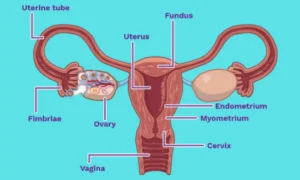
- Production of female sex hormones (estrogen and progesterone)
- Production of ova (eggs) through a process called ovulation
- Providing a site for fertilisation
- Supporting fetal development during pregnancy
- Enabling childbirth through the birth canal
- Menstrual cycle regulation
Anatomy of the Female Reproductive System
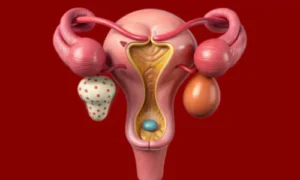
The female reproductive system is divided into two main parts:
1. External Organs (Vulva)
These are the outer parts of the female reproductive system and include:
Labia Majora and Labia Minora: Protective folds of skin.
Clitoris: A highly sensitive organ involved in sexual arousal.
Urethral Opening: Where urine exits the body.
Vaginal Opening: Entrance to the internal reproductive organs.
2. Internal Organs
These organs are responsible for reproduction, menstruation, and fetal development.
a. Vagina
- A muscular canal that connects the cervix to the outside of the body.
- Serves as the passage for menstrual flow, intercourse, and childbirth.
b. Uterus (Womb)
- A hollow, pear-shaped organ where a fertilised egg implants and grows into a fetus.
- Has three layers: endometrium (inner lining), myometrium (muscular layer), and perimetrium (outer layer).
c. Fallopian Tubes
- Two narrow tubes connect the ovaries to the uterus.
- Fertilisation usually occurs here when a sperm meets the egg.
d. Ovaries
- Small, oval-shaped glands are located on either side of the uterus.
- Produce eggs (ova) and secrete female hormones—estrogen and progesterone.
e. Cervix
- The lower, narrow part of the uterus that opens into the vagina.
- Produces mucus that helps or hinders sperm entry depending on the menstrual cycle.
Hormonal Regulation of the Female Reproductive System
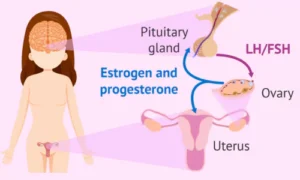
The system is tightly regulated by hormones released by the hypothalamus, pituitary gland, and ovaries. These hormones control the menstrual cycle, ovulation, and preparation of the uterus for pregnancy.
- FSH (Follicle Stimulating Hormone) – Stimulates follicle growth in ovaries.
- LH (Luteinizing Hormone) – Triggers ovulation.
- Estrogen – Prepares the endometrial lining for implantation.
- Progesterone – Maintains the uterine lining during pregnancy.
The Menstrual Cycle
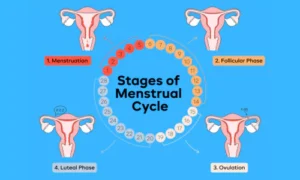
Typically lasting 28 days, the menstrual cycle has four phases:
1. Menstrual Phase (Days 1–5) – Shedding of the uterine lining.
2. Follicular Phase (Days 1–13) – Follicle development and estrogen increase.
3. Ovulation (Day 14) – Egg is released from the ovary.
4. Luteal Phase (Days 15–28) – Progesterone prepares the uterus; if no fertilisation, the cycle restarts.
Common Disorders of the Female Reproductive System
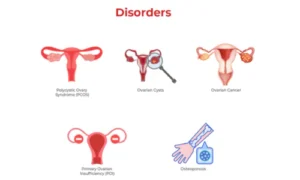
Understanding the system also involves awareness of conditions that can affect it:
- Polycystic Ovary Syndrome (PCOS)
- Endometriosis
- Uterine fibroids
- Infertility
- Cervical or ovarian cancer
- Menstrual irregularities
Conclusion
The female reproductive system is not only necessary for reproduction, but it also contributes significantly to hormonal balance and wellness. A thorough grasp of its anatomy and functions aids in raising awareness, early detection of reproductive health disorders, and supporting a healthy lifestyle. Whether you are a student, a parent, or simply inquisitive, learning about this system is an essential step toward comprehending the marvel of human life.
FAQs
1. What is the main function of the female reproductive system?
To produce eggs, support fertilisation, and nourish a developing fetus during pregnancy.
2. What are the primary hormones involved?
Estrogen, progesterone, follicle-stimulating hormone (FSH), and luteinizing hormone (LH).
3. What is ovulation?
The release of a mature egg from the ovary usually occurs around the 14th day of the menstrual cycle.
4. How many eggs does a woman have?
Women are born with about 1–2 million eggs; by puberty, around 300,000 remain, and only about 300–400 will be ovulated.
5. Can reproductive system disorders affect fertility?
Yes, conditions like PCOS, endometriosis, and blocked fallopian tubes can impact fertility.



